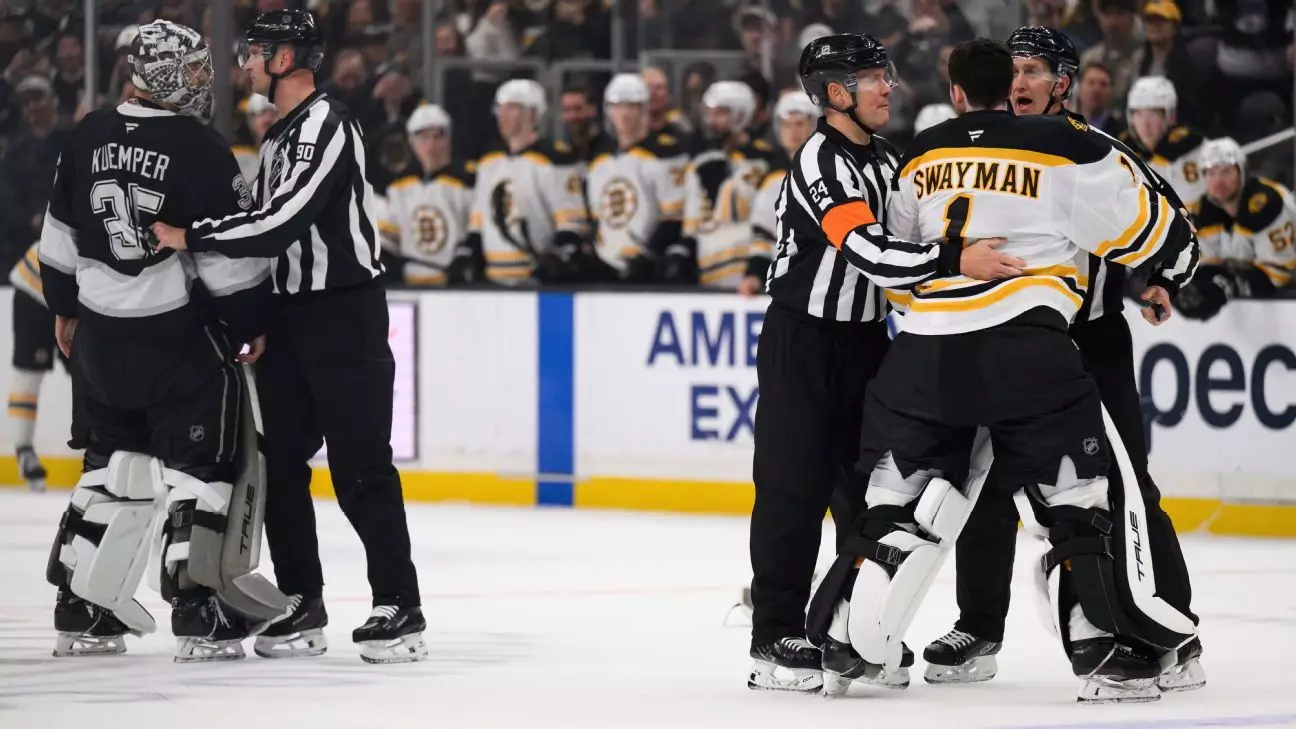There’s a palpable electricity in the air when two teams with distinct rivalries face off, and the recent matchup between the Los Angeles Kings and the Boston Bruins was no exception. As tensions escalated, the near-brawl between goalies Darcy Kuemper and Jeremy Swayman became the talk of the evening, igniting fans’ imaginations about what could have been. This scenario captured not merely a moment of potential violence but something more intricate: the passion and stakes of high-stakes hockey. It highlighted the fine line that goalies walk between being protectors of their net and engaged warriors in the ferocity of the game.
The Inciting Incident
The beginnings of chaos unfolded when Bruins forward Marat Khusnutdinov collided with Kuemper after an aggressive hit from Kings forward Tanner Jeannot. This collision ignited Kuemper, leading him to take matters into his own hands—a response that many would argue is instinctive for a goalie who routinely puts himself in harm’s way. Grabbing Khusnutdinov and deridingly removing his helmet may seem banal at first glance; however, this act was signaling a deeper conflict, one rooted in the underlying emotions that provide the foundation for rivalries. Swayman’s reaction by stepping onto center ice to challenge Kuemper speaks to a code of brotherhood and protection among goalies; despite being on opposing teams, they share the nuanced struggles unique to their position.
Officials Intervene: The Dilemma of Fighting
Amid the tension, the enforcers of the game—referees and linesmen—played a pivotal role. The inability of the goalies to engage in a fight drew mixed reactions. On the one hand, fans love the raw, unfiltered excitement of a brawl, but there’s a contrasting sentiment from coaches and management, like Kings’ Jim Hiller, who is understandably concerned about the potential injuries and disruption to their roster. The strategic importance of keeping players healthy for the long season is paramount, particularly for a team like the Kings, currently demonstrating an impressive home record.
The last significant goalie fight in the NHL, prior to this resurgence of intensity, dates back to February 2020, revealing how the culture around fighting in hockey has evolved—or waned—considerably over recent years. The aforementioned attempts by Swayman and others show that the spirit of competition is alive and well, though the game has shifted toward preventing such confrontations.
Player Perspectives: A Dance of Emotions
Both goalies receiving minor penalties for leaving their direct area encapsulates the traditions and rules that govern the game. Adrian Kempe’s remarks about the “heated moments” point toward the intricate emotions woven into the sport. In essence, hockey isn’t just about physical prowess but also understanding the emotion that charges players in critical moments. The implications of this are significant: while fans crave the thrill of corporeal engagement, the athletes themselves often wrestle with the delicate balance of protecting themselves, their teams, and the integrity of the sport.
The narratives formed during confrontation—both on and off the ice—speak to the broader themes within hockey culture: respect, rivalry, and the inevitable chaos that seems to coincide with competitive spirit. In that light, it becomes clear that while official interpretations may shun fighting, fans and players alike revel in the emotional stakes.
A Shift in Hockey Culture
The recent incident calls into question the changing landscape of hockey. With an increased emphasis on safety and player well-being in recent years, there remains an ongoing debate about the role of fighting within the sport. In the eyes of players and fans, there’s an unmistakable allure surrounding brawls: the thrill, the unpredictability, and the deep-rooted tradition that it invites. Yet, the reality is that the game is evolving.
It seems there is a tension between nostalgia and modern expectations. The traditional understanding of hockey’s fierceness is evolving, as modern players are more cognizant of their bodies and careers, positioning themselves within a framework of sustainability rather than brutishness. The anticipation of a goalie clash might still thrill fans, yet it begs a reevaluation of what it means to be a warrior on ice, as adaptability becomes necessary in crossing this competitive frontier.
Amid the increasing focus on strategy, skill, and finesse in hockey, the near-fight between Kuemper and Swayman unraveled a complex tapestry of tradition, rivalry, and emotional intensity that continues to define the sport.


Leave a Reply